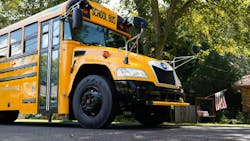Blue Bird aims higher in fiscal 2025 after hitting 2024 goals
Blue Bird Corp.’s fiscal 2024 has come to a close, and it was one for the books. Higher sales prices, record profits, and a healthy backlog were just a few of the points CEO Phil Horlock emphasized during the bus maker’s November 25 fourth-quarter earnings call. Blue Bird brought in a record $1.35 billion in revenue for the full year, a $200 million jump from 2023.
In the three months that ended September 28, Blue Bird sold 2,466 units and generated $350 million in net revenue. Both figures were roughly 15% higher year over year. Of the units sold, 84 were EVs, which was half the number of a year prior. CFO Razvan Radulescu said the drop was largely due to the delivery dates for some of the vehicles, which has pushed them into 2025.
See also: Blue Bird debuts electric step van
On the subject of Blue Bird’s EV business: Of the 9,000 units sold for the year, 700 were electric. While that’s less than 10% of total volume, it’s a 30% increase compared to 2023 and one of the reasons the company’s bottom line—$115 million, triple what it was in 2023—did so well in 2024, according to Horlock.
“Throughout the fiscal year, we maintained our very strong mix of alternative-powered vehicles,” he said on the conference call. “The higher margins and higher owner loyalty from these propane, gas, and electric buses contributed to our outstanding full-year profit improvement.”
As a whole, alternative-powered buses made up 58% of the company's unit sales in 2024. To date, Blue Bird has 2,000 zero-emission buses on the road carrying roughly 15,000 students per day. That 2,000 number should grow by 1,150 next year, largely thanks to the federal government.
The Environmental Protection Agency’s Clean School Bus Program provides $5 billion over five years to replace existing school buses with clean, zero-emission vehicles. To date, the EPA has awarded almost $3 billion to nearly 1,300 schools and federally recognized Tribes and U.S. territories.
Blue Bird received the lion’s share of orders from the first round, which concluded in 2022. Horlock said during the company’s August 7 conference call that his teams were “just beginning” to see orders from the second and third rounds.
The company’s backlog for the buses shows as much: Of the 4,800-strong 2025 orders, 630 were for EVs, representing $200 million of the estimated $735 million the backlog is worth.
In September, the fourth, and most recent, round of school bus funding opened with $965 million available. The winners of the round, which closes in January, will provide an all-but-guaranteed stream of orders to support Blue Bird past 2025. Awardees are expected to take possession of those buses by May 2027.
Blue Bird’s other 2025 projections include producing 9,250 buses, generating $1.45 billion in revenue and an adjusted EBITDA of $200 million. In the first quarter of 2025, executives target 2,000 units produced, representing approximately $300 million in revenue.
Shares of Blue Bird (Ticker: BLBD) have fluctuated over the past six months, hitting a high of $44.23 and a low of $36.27. Blue Bird’s share price initially dropped $4 to $38.87 when it opened on November 26 after reporting earnings but has since recovered. The price now sits around $42, putting the company’s market capitalization at $1.3 billion.
About the Author

Jennifer Ramsay
Jennifer Ramsay is an editor-at-large at Endeavor Business Media. In her role, Ramsay is responsible for curating several of the Market Moves newsletters and keeping tabs on the latest in the world of electric vehicles and clean energy.
